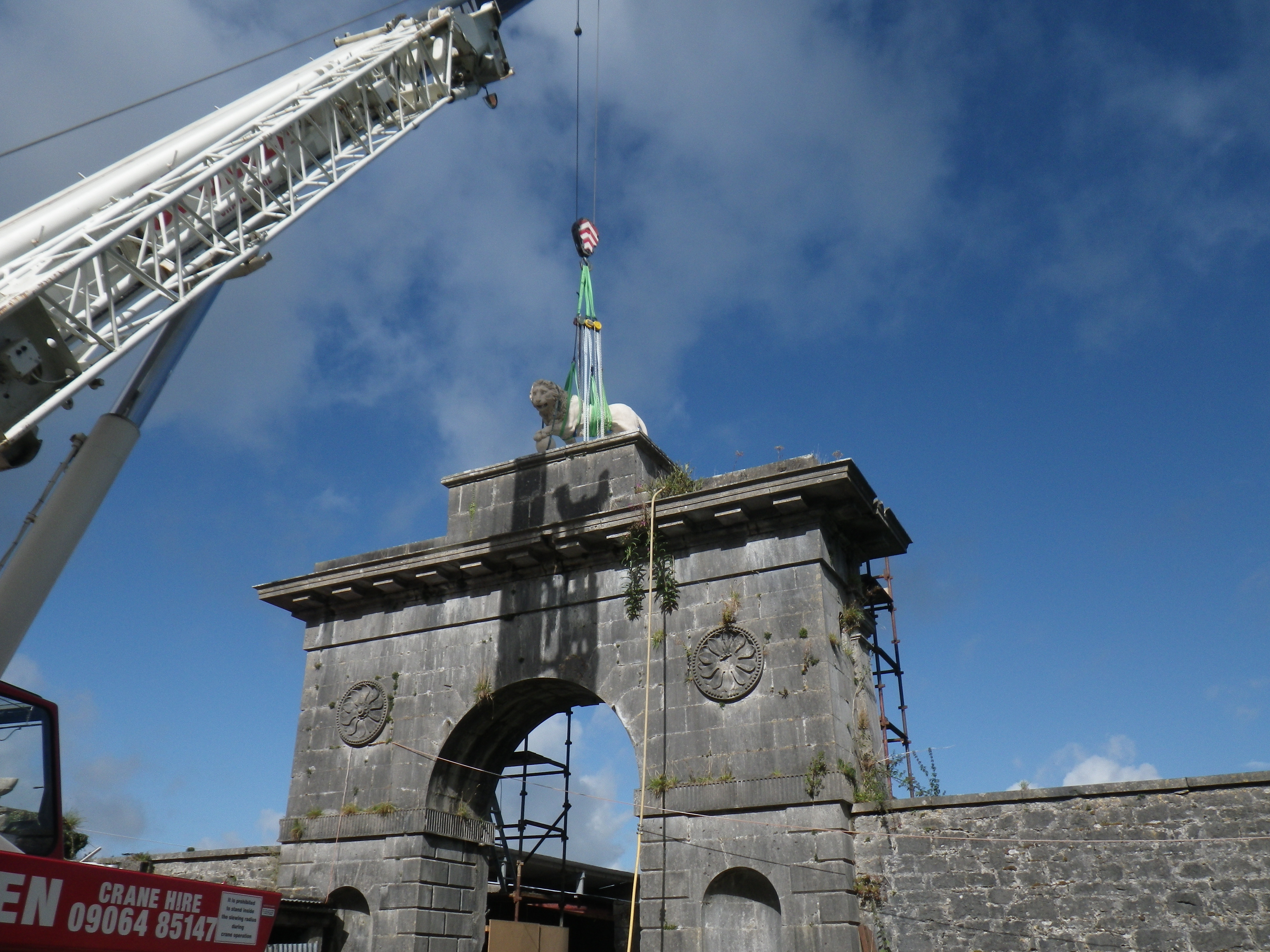IGS Conservation Project Highlight: The Lion’s Gate at Mote Park
13.07.2020
Posted by IGS

IGS visiting the Lion's Gate at Mote Park with Mote Park Conservation Group, prior to its conservation
The following text was written by David Molloy of Roscommon Heritage and featured in the 2016 edition of the Irish Georgian Society Review.
Mote Park came into the possession of the Crofton family in the 1660’s. They lived there up until the 1950s and the period of the family’s residence was to see the evolution of Ireland and in particular Roscommon, in terms of politics and economics, and the evolution of fashion in terms of landscaping and architecture. The family had a number of branches around the country. The early photographer Augusta Crofton was a member of one of these familial boughs.
Mote Park House was the centre piece of the demesne. It had been rebuilt in the 1860s following a fire. One of the estate features is its imposing entrance gate/archway dating from 1787, of which there were a few. The original Athlone/Roscommon main road runs over a gentle incline followed by a steep descent. From the ‘gentler’ side a road led to this locally sourced limestone entrance, that included an iconic lion and globe. Its flanks are surmounted by an urn on each. Built around the time of the previous 1860s house, the gate is thought to have Gandon influences.
The lion is comprised of Coadestone, a composite invented by Eleanor Coade and made from crushed sand, porcelain and glass, heated to a high temperature. Moulded and with a hollow stomach, the lion appears like stone but its detail has proved more long lasting. Access to the interior is through the mouth and this has provided a home/hive for bees for many decades —they stood guard and possibly protected the lion from vandalism or theft.

Close up view of Coade stone lion prior to its removal for conservation
Following the construction of a new Athlone/Roscommon road on the Ballymurray side of the estate, the original entrance fell into disuse. The lion faces down towards the site of the house with its rear to the old original road. The structure cannot be seen from any of the roads and is approached by an avenue. However, it could be seen from the house. Roscommon Heritage Group had previously re-roofed the Crofton mausoleum and conserved its fine interior nearby. Over the past 20 years or so the Group has engaged with the owners (the Rogers family) whose Grandfather had rescued it from demolition. Initial repairs included removal of growth and realigning the upper level significant stones.
We are fortunate to have an Architect on the Committee, Ms. Mary O’Carroll. As secretary she guided us on approaches and submissions to make further conversation. In parallel with our work, Eilish Feeley and her Mote Park Conservation Group have overseen the introduction of walks and preservation of areas of interest with an emphasis on flora and wildlife. It has made our tasks more appealing.

Re-installation of the restored Coade stone lion at Mote Park
The condition of the lion had begun to deteriorate at an alarming rate, with cracks appearing on the limbs. The Irish Georgian Society (in particular Primrose Wilson) approached us. Following a report by Eoghan Daltun Sculpture Ltd., it became obvious that repair was urgent.
The bees within the lion posed a serious problem. Over a period of months, local beekeepers, Jimmy Gleeson and Frank Kenny extracted new hives to keep the strain alive. NUIG was given samples to examine the possibility of the bees being virus free and healthy. It was decided to send the lion to Steve Pettifer, Coadestone Ltd. of Wilton, Wiltshire, UK. Steve had not seen this particular design before.
Following the lion’s head being bound the night before, it was disconnected (with some difficulty) by local builder, Gerry Dervin and his son Eoin. As it was removed from its plinth, the paws and globe fell off. Frank Scott (committee member) had the free loan of a van from Nick Craigie, Extraction Ltd. and drove to Wiltshire for six hours (it transpired there were two Wiltons—but the sat nav didn’t know!).

Re-installation of the restored Coade stone lion at Mote Park
Advised by Nollaig Feeney, Roscommon County Council Heritage Officer, it was prepared for travel. Within two to three weeks it was collected and returned to its site-looking magnificent and a testament to an innovative woman ahead of her time.
In addition to a grant of €10,000 from IGS London and a further grant of €3,000 from IGS Inc, funding was also provided by Roscommon County Council, the Dept. for Arts, Heritage and the Gaeltacht, The Follies Trust, Roscommon Heritage Group and anonymous donations.
The conservation of the Coade Stone lion at Mote Park in 2016 by the Roscommon Heritage Group was supported through a grant of €10,000 from IGS London and further support from IGS Inc (USA), as well as funding from Roscommon County Council, the Dept. for Arts, Heritage and the Gaeltacht, The Follies Trust, Roscommon Heritage Group and anonymous donations.
Between 2000 and 2020, through the support of its members in IGS Inc and IGS London, the Irish Georgian Society has awarded in excess of €1.25m through its conservation grants programme to building conservation projects throughout Ireland.